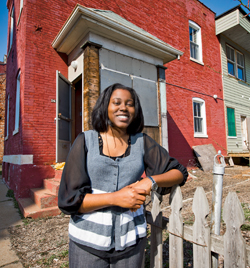
CGI U annually sets aside 200 of the 1,200 spots for students from the host institution. Knowing that civic engagement is such an integral part of the mission of Washington University, CGI U knew there would be a competitive base of applicants from which to choose. More than 400 WUSTL undergraduate and graduate students applied. The 201 students accepted collaborated on 116 enterprising commitments to action, aimed at solving a challenge in one or more of CGI U’s five focus areas: education, environment and climate change, peace and human rights, poverty alleviation, and public health. The following two examples highlight the creativity involved.
D*Serve (Design Serves)
De Andrea Nichols (above), Brown School
De Andrea Nichols seeks to inspire youth who live in under-resourced areas to become design-based entrepreneurs. Germinating in St. Louis’ Hyde Park neighborhood, D*Serve aims to help teens foster innovative, sustainable ideas and to guide them toward revitalizing the culture, physical spaces and socio-economy of their community.
“Within the larger design movement, there is a growing interest in human-centered design,” says Nichols, who is a candidate for an MSW with a concentration in social and economic development. “This project allows us to work in the best of both worlds — serving the community and being as creative as possible in order to do that.”
D*Serve is a partnership with the Rebuild Foundation and was highlighted by Chelsea Clinton during an April 6 press conference.
Interactive Living Landscape
Andrea Godshal, Sam Fox School of Design & Visual Arts; Ginny Spernoga, Brown School; Maria Stoica, School of Engineering & Applied Science; Jason West, University College
This team intends to demonstrate that vacant, contaminated urban lots can be productively landscaped not only to heal the soil, but also to help improve the health of the wider community.
Working at the McPherson Community Garden in St. Louis, these four students, representing a range of disciplines, hope to promote healthy soil by removing hazards, conserving site resources, and fostering a native habitat. The use of phytoremediation techniques, for example, allows contaminants to be removed in a non-intrusive, sustainable way.
The team members also see their commitment as a way to engage the community, as they work together to restore an aesthetic and useful green space.
Visit cgiu.wustl.edu for videos on student commitments.